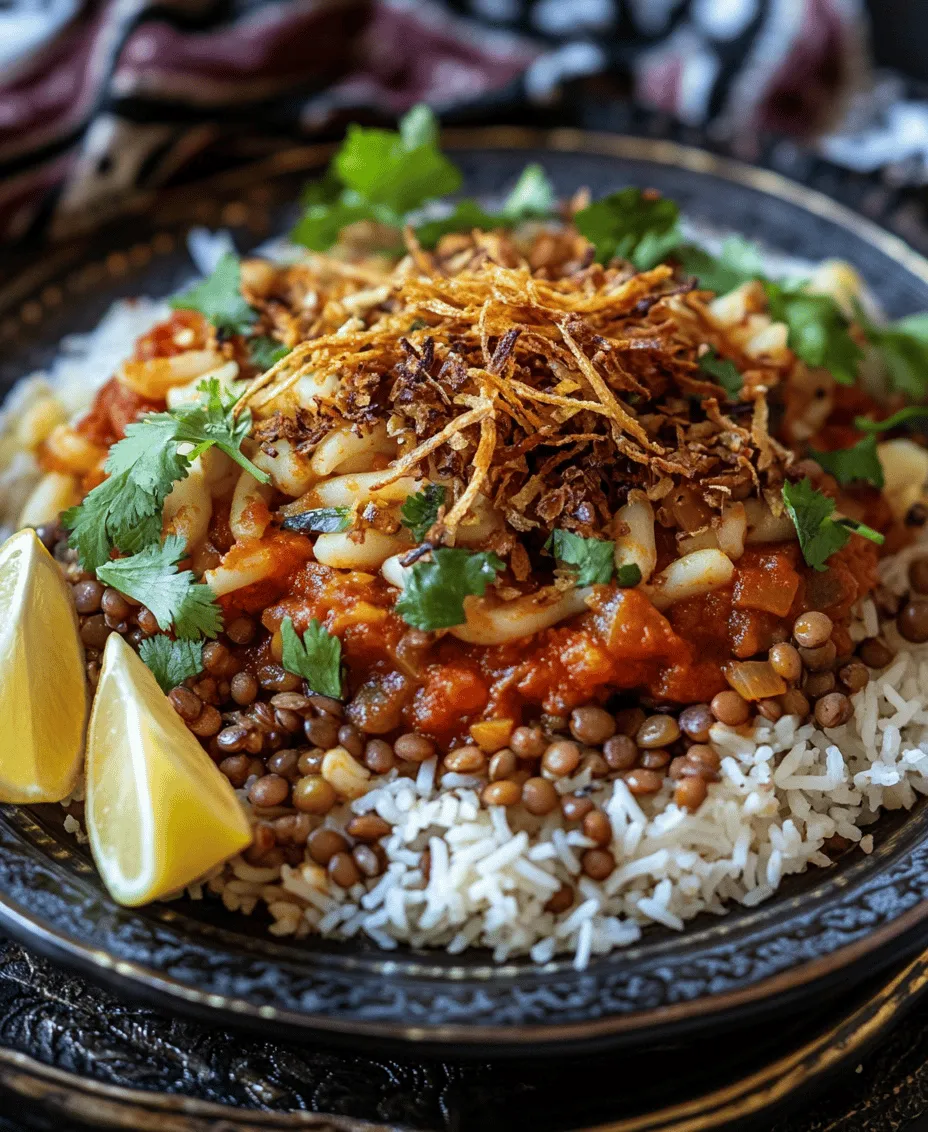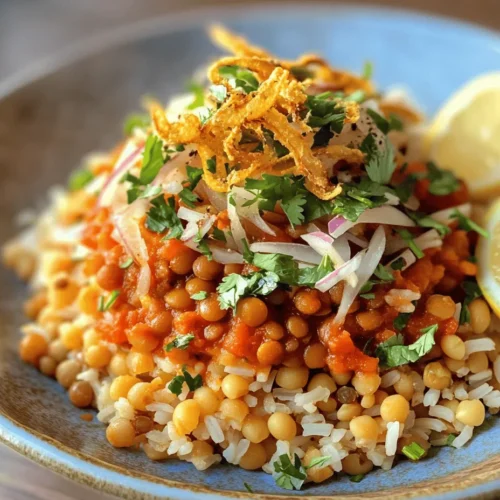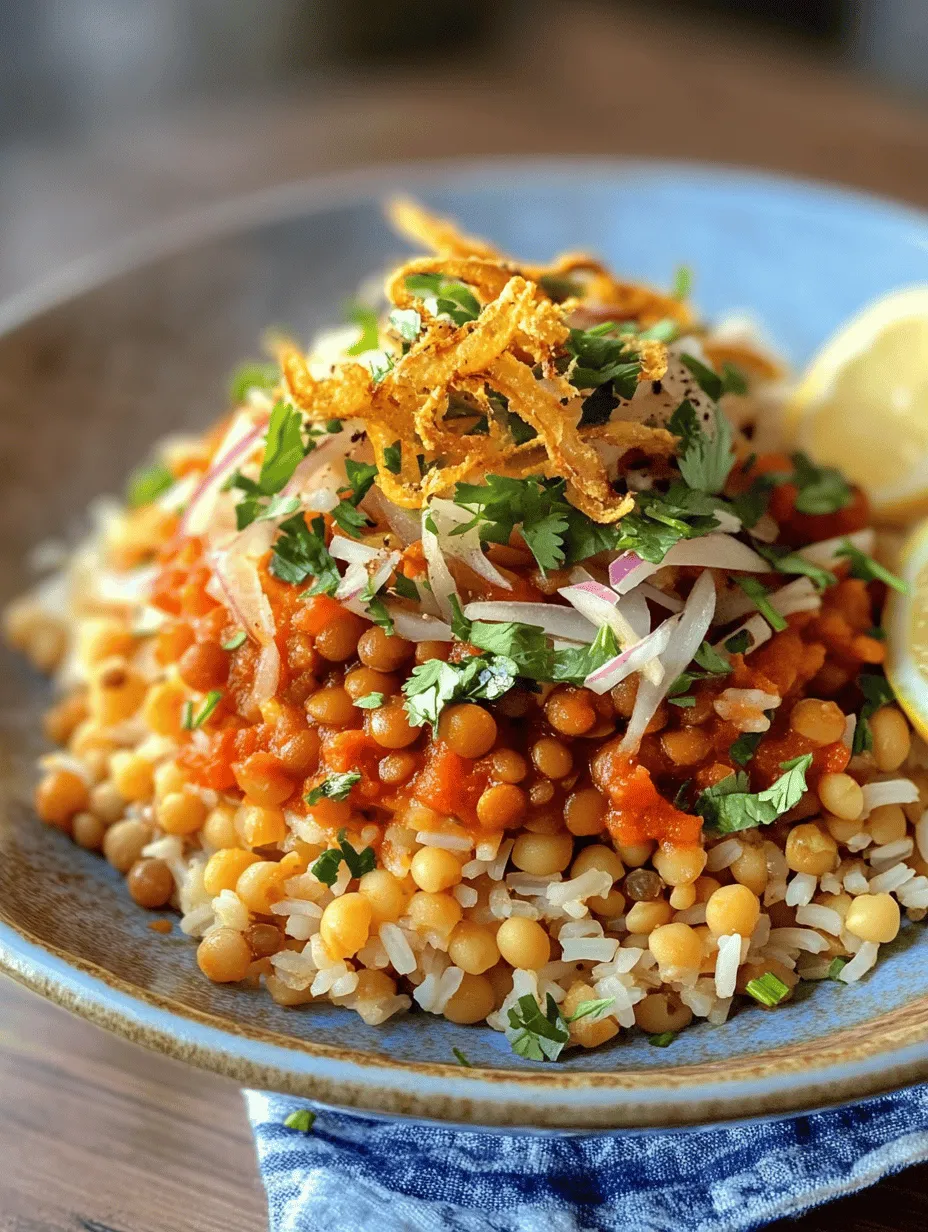Introduction to Koshari: A Taste of Egypt
Koshari is more than just a dish; it is a culinary journey that takes you straight to the heart of Egyptian culture. This hearty meal combines lentils, rice, macaroni, and a robust tomato sauce, creating a delightful blend of flavors and textures that satisfies both the palate and the soul. As one of the most popular street foods in Egypt, Koshari has become a staple in households, served not only as a daily meal but also during family gatherings and celebrations. Its comforting nature and rich taste make it a dish that brings people together, highlighting the communal aspect of dining in Egyptian society.
The beauty of Koshari lies not only in its flavor but also in its history. This dish reflects the diverse influences that have shaped Egyptian cuisine over centuries, melding flavors and ingredients from various cultures. As we delve deeper into this recipe, we will explore the origins of Koshari, its significance in Egyptian society, and the nutritional benefits of its key ingredients. We will also guide you through the step-by-step process of preparing this beloved dish, ensuring that you can recreate it in your own kitchen.
The Rich History of Koshari
Origins of Koshari in Egyptian Cuisine
Koshari traces its origins back to the streets of Cairo in the 19th century. While the exact timeline is debated, it is widely believed that the dish emerged during the British occupation of Egypt, influenced by Indian and Italian cuisines. The basic components of Koshari—rice, lentils, and pasta—are a testament to this fusion, showcasing how different cultures can come together to create something unique and delicious.
Originally, Koshari was a simple, affordable meal enjoyed by the working class. Street vendors would sell it from carts, allowing everyone to indulge in this hearty dish without breaking the bank. Over time, Koshari evolved into a national dish, celebrated for its flavor and versatility. Today, it is a common sight in both casual eateries and upscale restaurants across Egypt, illustrating its significant place in the nation’s culinary landscape.
Koshari’s Role in Egyptian Society
Koshari is more than just a meal; it embodies the spirit of Egyptian hospitality and community. Often served during social gatherings, family events, and celebrations, this dish has become synonymous with comfort and togetherness. In many households, Koshari is prepared on special occasions, bringing friends and family together around the dining table.
The communal aspect of Koshari is further emphasized in its serving style. Traditionally, it is presented in a large bowl, allowing diners to serve themselves and customize their portions. This practice not only encourages sharing but also fosters conversation and connection among those gathered. In a fast-paced world, Koshari serves as a delicious reminder of the importance of slowing down and enjoying meals with loved ones.
Understanding the Key Ingredients in Koshari
To truly appreciate the richness of Koshari, it is essential to understand the key ingredients that make up this iconic dish. Each element contributes to the overall flavor and texture, creating a harmonious blend that is both satisfying and nutritious.
Lentils: The Protein Powerhouse
At the heart of Koshari are lentils, often regarded as a protein powerhouse. These tiny legumes are not only rich in protein but also packed with fiber, making them an excellent choice for a filling meal. Lentils are known for their numerous health benefits, including improved digestion, heart health, and blood sugar regulation.
When cooked, lentils absorb flavors beautifully, taking on the spices and seasonings they are combined with. In Koshari, they provide a hearty base that complements the rice and pasta, ensuring that every bite is both flavorful and nutritious.
Rice and Macaroni: The Starchy Staples
Koshari wouldn’t be complete without its starchy components: rice and macaroni. The combination of these two staples not only adds texture but also enhances the dish’s overall heartiness. Rice serves as a fluffy, light foundation, while the macaroni contributes a satisfying chewiness that contrasts with the other ingredients.
To achieve the perfect balance in Koshari, it is crucial to cook both the rice and macaroni correctly. Properly cooked rice should be fluffy and separate, while the macaroni should be al dente to maintain its texture. The interplay of these two elements creates a delightful mouthfeel that enhances the overall dining experience.
The Flavor Profile: Spices and Sauces
The flavor profile of Koshari is elevated by a blend of spices and sauces that bring warmth and depth to the dish. Essential spices such as cumin, coriander, and paprika add aromatic notes that enhance the taste of the lentils, rice, and macaroni. These spices are often used in the preparation of the tomato sauce, which is a vital component of Koshari.
The tomato sauce, typically made with fresh or canned tomatoes, garlic, and a hint of chili, provides a tangy and slightly spicy contrast to the starchy base. This sauce not only brings the dish together but also adds moisture, ensuring that every bite is packed with flavor. The balance of spices and sauce is what truly makes Koshari a standout dish.
Optional Ingredients: Customizing Your Koshari
One of the beautiful aspects of Koshari is its versatility. While the classic recipe is beloved, many cooks enjoy customizing their Koshari with optional ingredients. For those who like a bit of heat, a sprinkle of chili powder can be added to the tomato sauce for an extra kick. Additionally, various vegetables such as sautéed bell peppers or carrots can be incorporated to add color and nutrition.
If you want to enhance the protein content further, consider adding cooked chickpeas or fried eggs on top of the Koshari before serving. These additions not only make the dish more filling but also allow you to tailor it to your dietary preferences.
Step-by-Step Instructions to Make Koshari
Creating the perfect Koshari involves several steps, each crucial to achieving the desired flavor and texture. Below, we outline the initial steps to prepare this iconic dish, ensuring that you can replicate the experience of enjoying authentic Koshari at home.
Preparing the Lentils
To begin, it is essential to prepare the lentils correctly. Start by rinsing the lentils thoroughly under cold water to remove any dust or debris. In a saucepan, combine the rinsed lentils with water, using a ratio of about 1 cup of lentils to 3 cups of water. Bring the mixture to a boil, then reduce the heat and let it simmer for approximately 20 to 25 minutes. The goal is to achieve tender lentils that hold their shape, so be sure to check for doneness regularly. Once cooked, drain any excess water and set the lentils aside.
Cooking the Rice
Next, it’s time to cook the rice. Rinsing the rice under cold water is essential to remove excess starch, which can cause the rice to become sticky. In a separate pot, combine 1 cup of rice with 2 cups of water and a pinch of salt. Bring the mixture to a boil, then reduce the heat to low, cover, and let it simmer for about 15 minutes. After the cooking time is up, remove the pot from the heat and let it sit, covered, for an additional 5 minutes. Fluff the rice with a fork before incorporating it into the Koshari.
Making the Perfect Macaroni
For the macaroni, bring a pot of salted water to a boil and add the macaroni. Cook according to the package instructions until al dente, usually around 7 to 9 minutes. Be careful not to overcook the pasta, as it should retain a slight bite to complement the other ingredients. Once cooked, drain the macaroni and rinse it under cold water to stop the cooking process. Set it aside for later use in the Koshari assembly.
Frying the Onions for Crunch
One of the signature toppings of Koshari is crispy fried onions. To achieve the perfect crunch, slice a medium onion thinly and soak the slices in cold water for about 10 minutes. This step helps to remove some of the onion’s sharpness. In a frying pan, heat a generous amount of oil over medium heat. Once the oil is hot, add the onion slices and fry until they turn golden brown and crispy. This process usually takes about 5 to 7 minutes. Once done, use a slotted spoon to transfer the fried onions onto a paper towel-lined plate to absorb excess oil.
Creating the Tomato Sauce
The final step in the preparation process is to create the flavorful tomato sauce that will tie the dish together. In a saucepan, heat a bit of oil and sauté minced garlic until fragrant, being careful not to let it burn. Add diced tomatoes (fresh or canned) and stir in spices such as cumin, paprika, and a pinch of salt. Allow the sauce to simmer for about 15 minutes, letting the flavors meld together. You can also add chili powder if you desire some heat. Once the sauce has thickened slightly, remove it from the heat and set it aside.
As you can see, the journey to prepare Koshari is as rich and satisfying as the dish itself. With each component carefully crafted, you are well on your way to creating a meal that embodies the vibrant culinary heritage of Egypt. Stay tuned for the next part, where we will guide you through assembling this delightful dish and provide tips for serving and enjoying Koshari to its fullest.

Making the Sauce
To elevate your Koshari to new heights, let’s focus on crafting the flavorful sauce that brings this dish together. Start by heating a generous amount of olive oil in a medium-sized saucepan over medium heat. Once the oil is shimmering, add in finely chopped garlic—about six cloves should suffice for a robust flavor. Sauté the garlic until it turns golden brown, releasing its fragrant aroma. Be cautious not to burn it, as burnt garlic can impart a bitter taste to your sauce.
Next, it’s time to add the spices that will define the sauce. Sprinkle in a teaspoon of cumin, a teaspoon of coriander, and a pinch of red pepper flakes for a subtle kick. Stir the mixture for about 30 seconds to allow the spices to bloom in the oil, enhancing their flavors.
After this, pour in two cups of crushed tomatoes—canned or fresh, depending on your preference. Stir well to combine all the ingredients. Reduce the heat to low and let the sauce simmer for approximately 15-20 minutes. This simmering process allows the flavors to meld beautifully, creating a rich, savory sauce that will coat the Koshari perfectly. For a hint of acidity, add a teaspoon of vinegar or lemon juice towards the end of the cooking time, adjusting to taste.
Combining All Ingredients
Now that your sauce is ready, it’s time to layer the components of Koshari for optimal presentation and flavor integration. Begin by placing a generous serving of the cooked rice and lentils mixture in the center of a large serving platter or individual bowls. This base is essential for capturing the flavors that will be added later.
Next, gently spoon the tomato sauce over the rice and lentils. The sauce should be warm, radiating enticing aromas throughout the dish. Use the back of the spoon to create a little well in the center, allowing the sauce to pool slightly. This presentation not only looks appealing but also ensures every bite is infused with the rich tomato flavor.
Finally, top the sauced base with a handful of cooked macaroni. While not traditional in every household, the addition of pasta is what many Egyptians consider essential for a true Koshari experience. It adds a delightful texture and serves as an enjoyable contrast to the rice and lentils.
Adding Chickpeas for Texture
Chickpeas play a vital role in Koshari, both in terms of texture and nutritional content. After layering the rice, lentils, sauce, and macaroni, it’s time to add the chickpeas. Use canned chickpeas for convenience, but if you prefer the taste of freshly cooked ones, soak dried chickpeas overnight and boil them until tender.
Sprinkle a generous handful of chickpeas over the top of your layered dish. Their creamy texture complements the other ingredients perfectly while providing a hearty protein boost. Chickpeas not only enhance the overall flavor of Koshari but also make it a more satisfying meal, perfect for fueling a long day.
Serving and Garnishing Koshari
Serving Koshari is an art in itself. To achieve the traditional look, garnish the dish with a generous amount of crispy fried onions. You can either purchase these pre-made or make your own by thinly slicing onions, coating them in flour, and frying them until golden and crispy. These fried onions add a delightful crunch and a burst of flavor.
For an extra touch of freshness, consider garnishing with freshly chopped parsley or cilantro. Sprinkle a small handful over the top just before serving. This not only elevates the presentation but also adds a hint of herbal freshness that balances the richness of the dish.
Koshari is best enjoyed hot, with each component still warm and flavorful. To serve, provide your guests with a side of extra tomato sauce for those who prefer a saucier dish.
Nutritional Benefits of Koshari
A Balanced Meal
Koshari is celebrated not just for its delightful taste but also for being a well-rounded meal. It combines carbohydrates from rice and pasta, proteins from lentils and chickpeas, and healthy fats from olive oil. This balance makes it a satisfying dish that can serve as a complete meal.
The complex carbohydrates found in the rice and lentils provide sustained energy, making Koshari an excellent choice for lunch or dinner. Furthermore, the protein content helps to repair and build tissues, while the healthy fats support overall health.
Health Benefits of Key Ingredients
Delving deeper into the components of Koshari reveals its nutritional advantages. Lentils, for instance, are a fantastic source of plant-based protein, fiber, and essential vitamins such as B vitamins. They help in maintaining digestive health and can contribute to heart health by managing cholesterol levels.
Chickpeas, another significant ingredient, are rich in fiber, which aids in digestion and helps regulate blood sugar levels. They also contain essential minerals like iron and magnesium, which are vital for various bodily functions.
The spices used in the sauce, such as cumin and coriander, not only enhance flavor but also offer health benefits. Cumin is known for its antioxidant properties, while coriander can help improve digestion. Together, these spices contribute to the overall healthiness of Koshari.
Vegetarian and Vegan-Friendly Options
Koshari is an excellent option for those following vegetarian or vegan diets. With its plant-based ingredients, it provides a hearty meal without any animal products. This versatility makes it accessible for various dietary preferences, ensuring everyone can enjoy a taste of Egypt.
Variations of Koshari Around Egypt
Regional Differences
Koshari can vary significantly from one region of Egypt to another. In some areas, cooks may substitute brown rice for white rice, providing an alternative that enhances the dish’s fiber content. In coastal regions, you might even find seafood incorporated into Koshari, showcasing the local culinary influences.
Moreover, ingredient proportions can differ; some families may prefer more lentils, while others might load on the pasta. These variations reflect personal tastes and traditions, making Koshari a flexible dish that adapts to different palates.
Modern Twists on Traditional Koshari
In recent years, Koshari has also seen creative modern twists. Food enthusiasts have experimented with adding roasted vegetables or incorporating quinoa for a gluten-free option. Others have introduced spicy elements like harissa to the sauce for a contemporary zing.
While these modern adaptations maintain the spirit of Koshari, they also allow for innovation in an age where culinary boundaries are continually expanding.
Cultural Significance of Koshari
Koshari in Egyptian Celebrations
Koshari holds a special place in Egyptian culture, often served during festive occasions and family gatherings. It symbolizes togetherness, much like how families come together to share a meal. During Ramadan, for example, Koshari is frequently prepared as a fulfilling dish to break the fast, offering a hearty meal that nourishes both body and soul.
On holidays and during celebrations, you will often find Koshari gracing the tables, serving as a reminder of the rich culinary heritage of Egypt that brings people together.
The Street Food Culture
Koshari is also a beloved street food item in Egypt, commonly sold from small stalls and food carts. The experience of enjoying Koshari from a local vendor is a rite of passage for both locals and tourists alike. The bustling atmosphere, the tantalizing aromas wafting through the air, and the sight of vendors expertly assembling plates of Koshari create a unique culinary experience.
Street vendors often have their own secret recipes, passed down through generations, which adds to the charm of this dish. Eating Koshari from a street vendor allows one to connect with the local culture and tradition in a way that is both authentic and memorable.
Conclusion: The Timeless Appeal of Koshari
Koshari is more than just a meal; it is a symbol of Egyptian culture and hospitality. With its layers of flavors and textures, this dish has a way of bringing people together. Whether you are enjoying it at home with family or at a bustling street vendor, Koshari represents the rich culinary heritage of Egypt.
By following the steps outlined in this article, anyone can recreate this traditional dish and experience a taste of Egypt in their own kitchen. The combination of rice, lentils, chickpeas, and a spiced tomato sauce creates a harmonious blend that is both comforting and satisfying.
As you serve Koshari to your friends and family, you invite them into a world of flavors, history, and tradition. Each bite tells a story, making it a timeless dish that transcends generations. Embrace the art of making Koshari, and share this delightful experience with those around you, celebrating the essence of Egyptian cuisine.



